Solar EV Charging Station Market Overview
The global solar charging station market size was valued at USD 0.55 billion in 2021, and is projected to reach USD 2.88 billion by 2031, growing at a CAGR of 18.5% from 2022 to 2031. The global solar charging station market is set for strong growth driven by rising electricity and fossil fuel costs, surging EV demand, and supportive government incentives. Declining solar equipment costs and expanding EV infrastructure further create lucrative opportunities ahead.
Key Market Trend & Insights
- Type: Large charging station segment is expected to lead in growth rate globally.
- Application: Commercial segment is projected to dominate the global anti-drone market growth rate.
- Station Type: On-grid solar charging station segment is forecast to record the highest growth rate.
- Component: Battery energy storage system segment is anticipated to lead in growth rate worldwide.
Market Size & Forecast
- 2031 Projected Market Size: USD 2.88 billion
- 2021 Market Size: USD 0.55 billion
- Compound Annual Growth Rate (CAGR) (2022-2031): 18.5%
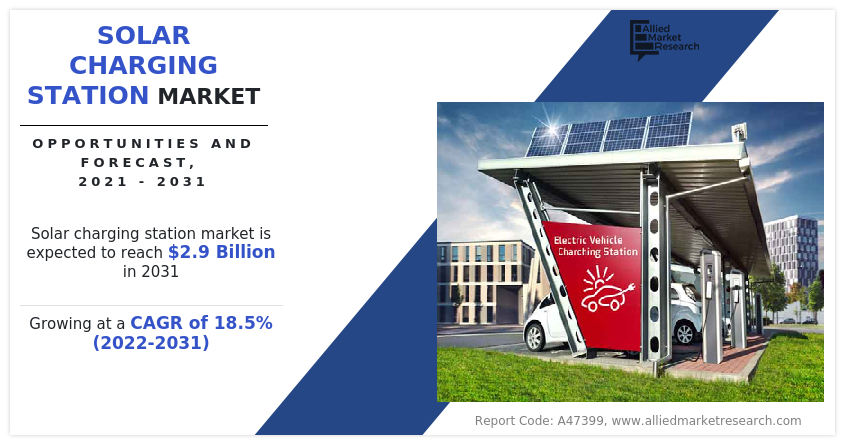
Introduction
Electric vehicles have increasingly become mandatory across the globe due to their positive impact on the environment. The government encourages drivers to use electric vehicles, which have less environmental impact than internal combustion engines. Typical charging stations are used to charge electric vehicles; however, it uses 40% to 60% of the country’s national grid power to charge vehicles made with non-renewable energy. Electric vehicles are more environment friendly, although they still use the grid power to charge the vehicle battery, which uses fossil fuels and other non-renewable energy sources. EVs still reduce their environmental impact, however, using EV charging stations running on non-renewable energy sources has continuous negative impact on the environment. Therefore, electrification alone is not enough to decarbonize transport. A solar charging station for electric vehicles is the solution to zero this emission. Not only it is good for the environment, however, it is also a big advantage for the vehicle fleet. A solar car charging station guarantees a 100% carbon-neutral footprint.
Market Dynamics
Solar charging stations consist of solar panels made up of photovoltaic (PV) cell blocks that are responsible for generating electricity from sunlight. The solar panel can charge multiple vehicles at the same time. Electric vehicles can be charged during power outages. Electric vehicles can be parked under the unit, so no parking space is lost. Installation of solar charging stations requires no permits, electrical work, civil engineering, or utility bills. The analysis conducted by National Renewable Energy Laboratory (NREL) and others confirmed that market projections for EV adoption are unlikely to materialize without routine access to charging infrastructure in both domestic & commercial locations. The lack of charging infrastructure is the major reason that impacts EV sales. One of the main barriers cited by potential EV buyers is the lack of readily available charging station options. One of the major factors driving the growth of the market is the surge in installation of solar energy for electricity worldwide.
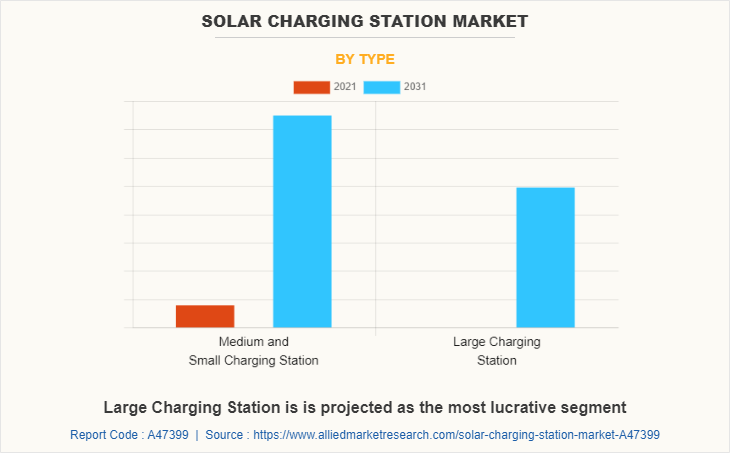
The global solar charging station market is expected to experience significant growth due to increase in costs associated with the production of electricity, rise in demand for EVs worldwide, and surge in costs of fossil fuels worldwide. However, excessive costs associated with the equipment requirements of solar stations and the high space needed for solar energy-based stations hamper the growth of the market. On the contrary, the rising need for EV charging stations to meet the demands for the ever-increasing EVs, government incentives & subsidies to promote the usage of solar energy, and declining costs & increasing affordability of solar equipment are the major factors that are expected to provide lucrative opportunities for market growth during the forecast period.
Market Segmentation
The solar charging station market is segmented into type, application, station type, component, and region. By type, the market is classified into medium & small charging stations and large charging stations. By application, it is bifurcated into household and commercial. Depending on station type, it is segregated into on-grid solar charging station and off-grid solar charging stations. By component, the market is categorized into EV chargers, solar panel arrays, battery energy storage systems, and others. Region-wise, the market is analyzed across North America, Europe, Asia-Pacific, and LAMEA.
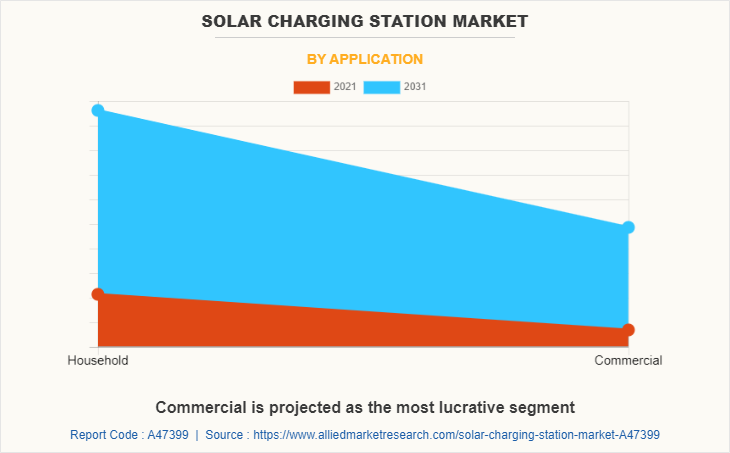
Which are the Top Solar Charging Station companies
The following are the leading companies in the market. These players have adopted various strategies to increase their market penetration and strengthen their position in the solar charging station industry.
- Giulio Barbieri SRL
- Inhabit Solar
- MDT Sun Protection System AG
- PROINSO
- Solarsense UK Limited
- Solarstone
- Sundial Solar Solutions
- SunPower Corporation
- Sunworx Solar
- VCT Group
What are the Top Impacting Factors
Key Market Driver
Increase in costs associated with the production of electricity
The overall costs associated with electricity production have been rising for the past couple of years. Electricity production is linked to variables such as procurement, transport, and storage of fossil fuels, as more than half of the worldwide production of electricity is through the medium of fossil fuels. All these factors are witnessing a rise in cost, which is directly impacting on the costs associated with the production of electricity. Furthermore, countries are tightening emission norms, which directly impacts existing coal firing thermal power plants. For instance, in 2021, the Union Ministry of Environment, Forest and Climate Change (MoEF&CC) of India released an amendment and revised existing emission norms for coal thermal power plants. All these factors are expected to increase the costs associated with the production of electricity, which is anticipated to drive the demand for renewable methods of electricity production such as solar based alternatives, which in turn is expected to drive the demand for solar charging station market share across the globe.
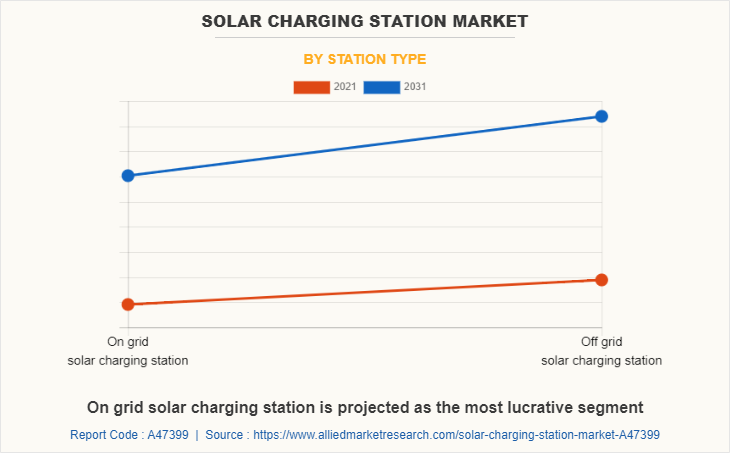
Rise in demand for EVs globally
There has been a constant rise in the adoption of electric vehicles, ever since they started becoming mainstream. Countries that spend a major chunk of their incomes on importing crude oil are witnessing a rise in the adoption of electric vehicles. This makes electric vehicles a viable and sustainable means of transportation for countries that rely heavily on imported crude oil, as well as countries where rising carbon emissions are a problem. The growing popularity of electric vehicles necessitates the establishment of a reliable charging network to accommodate the ever-expanding fleet of electric vehicles. For instance, in September 2022, the U.S. government approved plans to support the building of chargers by funding $1.5 billion in federal funding across all fifty states in the U.S. Similarly, in 2023, Tata Power, one of India’s’ largest EV charging solutions provider announced their plans to install around 25,000 new EV charging points across the nation in the next 5 years. In such instances, greener and sustainable technologies such as solar charging stations are sure to get traction in the future.
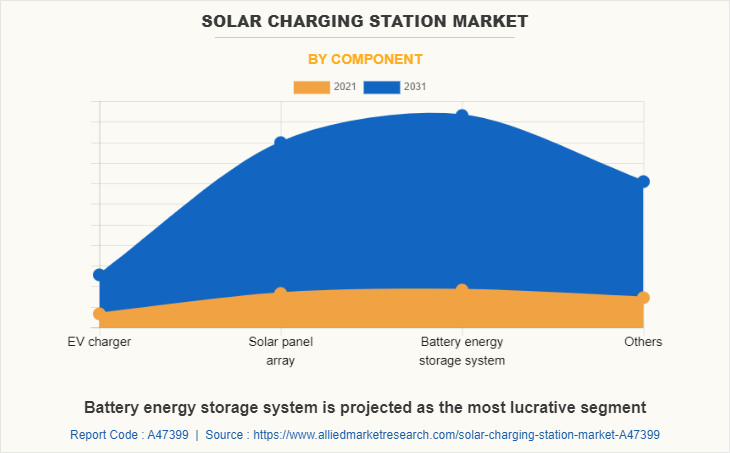
Restraints
Excessive costs associated with the equipment requirements of solar stations
All solar stations are comprised of three basic components, solar photovoltaic panels, an inverter, and an energy storage medium. For many years, batteries have been the prime method of storing electricity generated by solar photovoltaic cells. Whilst there has been a reduction in costs of solar photovoltaic panels and inverters used across commercial applications, the cost of storage systems has gone up. Since storage systems constitute a major chunk of the overall costs of a complete solution, the overall costs of solar stations are still high. In addition, the energy received from the sun varies with variables such as tracking capabilities and seasons, it becomes an irregular source of energy, thereby increasing the need for reliable storage solutions for smooth operations.
Furthermore, the current recycling techniques for recycling solar photovoltaic panels are inefficient and rarely deployed. Owing to this, elements such as silver, copper, and silicon, which together account for around two-thirds of the monetary worth of a silicon panel’s materials are rarely recycled back. This further hinders the initiative to keep the cost of solar equipment low. And, due to these reasons, the excessive costs associated with solar equipment is expected to hinder the growth of solar charging station market.
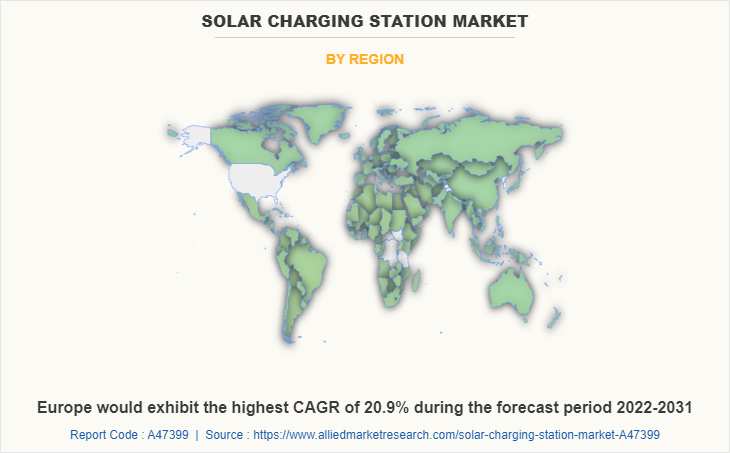
Oppoortunity
Government incentives and subsidies to promote the usage of solar energy
Solar energy as an energy source comes with many environmental and economic advantages. However, the widespread adoption of solar energy has been hampered by a lack of incentives and policies to encourage its use. To overcome this, governments across the globe are focusing on providing financial and regulatory incentives to encourage the adoption of solar based products. For instance, in the U.S. Department of Energy (DOE) solar energy technologies office (SETO) supports funding opportunities on photovoltaics, concentrating solar-thermal power, systems integration, as well as to cover the soft costs associated with the projects. Similarly, developing countries have started to shift their focus on renewable alternatives such as solar powered equipment.
For instance, the ministry of new and renewable energy, Government of India has numerous scheme that aid in funding of solar based projects. Furthermore, governments also offer tax credits and rebates for businesses to install solar panels. Thus, by reducing the upfront costs of installation, these incentives can increase the affordability of solar energy, making it more accessible to a larger portion of the population. These factors are expected to create numerous opportunities that are expected to result in the growth of the market in the future.
Key Benefits for Stakeholders
- This report provides a quantitative analysis of the market segments, current trends, estimations, and dynamics of the solar charging station market analysis from 2021 to 2031 to identify the prevailing solar charging station market opportunities.
- The market research is offered along with information related to key drivers, restraints, and opportunities.
- Porter's five forces analysis highlights the potency of buyers and suppliers to enable stakeholders make profit-oriented business decisions and strengthen their supplier-buyer network.
- In-depth analysis of the solar charging station market segmentation assists to determine the prevailing market opportunities.
- Major countries in each region are mapped according to their revenue contribution to the global market.
- Market player positioning facilitates benchmarking and provides a clear understanding of the present position of the market players.
- The report includes the analysis of the regional as well as global solar charging station market trends, key players, market segments, application areas, and market growth strategies
Solar Charging Station Market Report Highlights
| Aspects | Details |
| Market Size By 2031 | USD 2.9 billion |
| Growth Rate | CAGR of 18.5% |
| Forecast period | 2021 - 2031 |
| Report Pages | 376 |
| By Type |
|
| By Application |
|
| By Station Type |
|
| By Component |
|
| By Region |
|
| Key Market Players | Sundial Solar Solutions, SunPower Corporation, Solarstone, PROINSO, Giulio Barbieri SRL, VCT Group, Sunworx Solar, MDT SUN PROTECTION SYSTEM AG, Solarsense UK Limited, INHABIT Solar |
Analyst Review
The global solar charging station market is expected to grow at a remarkable rate in the future, owing to rising demand for electric vehicles and the government's encouragement to shift toward e-vehicle. To ensure that more people use solar-based energy generation, governments across the globe have introduced various subsidies in the form of exemptions from paying taxes related to it. For instance, the U.S. government offered a federal investment tax credit for the installation of commercial solar panels. A 26% tax credit is expected to be provided for solar panel systems whose construction commenced before December 31, 2022. After 2022, a 22% credit is anticipated to be provided, and 10% for those commencing in 2023.
The solar charging station manufacturers across the globe are working toward introducing advanced solar charging stations, which supplement the market growth. For instance, in June 2021, Tesla Inc opened a solar-powered charging station with on-site power storage in the Tibetan capital Lhasa. In recent years, a wide variety of electric cars are offered in the market. According to the International Energy Agency, sales of electric cars (including fully electric and plug-in hybrids) doubled in 2021 to a new record of 6.6 million. The market players are focusing on the development of solar charging stations due to an increase in demand for electric vehicles across the globe. Moreover, rise in popularity in solar charging stations helps to lessen carbon footprint and decrease grid load & charging cost, which is anticipated to foster the demand for solar charging stations during the forecast period.
The global solar charging station market was valued at $558.9 million in 2021, and is projected to reach $2,888.9 million by 2031, registering a CAGR of 18.5% from 2022 to 2031
The key players operating in the global solar charging station market are Giulio Barbieri SRL, Inhabit Solar, MDT Sun Protection System AG, PROINSO, Solarsense UK Limited, Solarstone, Sundial Solar Solutions, SunPower Corporation, Sunworx solar, and VCT Group
Asia-Pacific is the largest regional market for Solar Charging Station
Large Charging Station is the leading application of Solar Charging Station Market
Introduction of on grid solar charging station are the upcoming trends of Solar Charging Station Market in the world
Loading Table Of Content...



